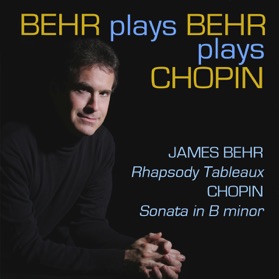PROGRAM NOTES: RHAPSODY TABLEAUX
Blue Age Piano (Fusion Jazz/Classical/New-Age)
James Behr completed Rhapsody Tableaux in 2007 following the loss of his beloved stepfather, Leo Breslau, a gifted artist whose works are displayed throughout the U.S., including The National Gallery of Art. The word “tableaux” (in French, picturesque scenes) was chosen to honor Mr. Breslau and reflect Rhapsody: a series of colorful musical vignettes. In this exciting and melodic work with moods ranging from jazzy to profound, Behr creates a uniquely American musical tableaux, a style he calls “Blue Age.” Rhapsody follows a loose sonata-allegro form, opening with a melodic idee fixe that becomes its foundation. The idee fixe is heard often and in varying moods. Following the lush introduction is a pulsating second theme, which, says the composer, “Brings me to the streets of New York” (where he lives). Colorful passages follow, ranging from charming to “scherzotic.” The enchanted “Sentimental“ arrives with two romantic melodies, followed by “Misterioso” (development) with a haunting reprise of the idee fixe. Recapitulation comes in the finalé “Glory” flowing with joyful and ragtime-ish episodes. Rhapsody concludes with driving, rhythmic passages of Rachmaninoff-like flair. reaching an exciting, final affirmation of the idee fixe.
© Rhapsody Tableaux by James Behr. All Rights Reserved.
Recorded in Patrych Studio, NY on a Steinway D.
James Behr is a Steinway Artist.


